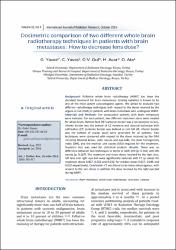Dosimetric comparison of two different whole brain radiotherapy techniques in patients with brain metastases: How to decrease lens dose?
Künye
Yavaş, G., Yavaş, Ç., Gül, O. V., Acar, H. ve Ata, Ö. (2014). Dosimetric comparison of two different whole brain radiotherapy techniques in patients with brain metastases: How to decrease lens dose? International Journal of Radiation Research, 12(4), 311-317.Özet
Background: Palliative whole brain radiotherapy (WBRT) has been the standard treatment for brain metastases. Ionizing radiation is known to be one of the most potent cataractogenic agents. We aimed to evaluate two different radiotherapy techniques with respect to the doses received by the organs at risk (OAR) in patients with brain metastasis who undergone WBRT. Materials and Methods: Ten consecutive patients with brain metastasis were included. For each patient, two different treatment plans were created for whole brain. Helmet-field (HF) (anterior border was 2 cm posterior to lens, inferior border was the bottom of C2 vertebra) and classical technique with collimation (CT) (anterior border was defined as skin fall off, inferior border was the bottom of cranial base) were generated for all patients. Two techniques were compared with respect to the doses received by the OAR including bilateral lenses, optic nerves and eye-balls, the dose homogeneity index (DHI), and the monitor unit counts (MU) required for the treatment. Student-t test was used for statistical analysis. Results: There was no difference between two techniques in terms of both DHI (p: 0.182) and MU counts (p: 0.167). The maximum and mean doses received by the right lens, left lens and right eye-ball were significantly reduced with CT (p values for maximum doses 0.007, 0.012 and 0.010; for median doses 0.027, 0.046 and 0.002 respectively). Conclusion: CT was found to be more advantageous, with respect to the lens doses in addition the dose received by the right eye-ball during WBRT.
WoS Q Kategorisi
Q4Kaynak
International Journal of Radiation ResearchCilt
12Sayı
4Koleksiyonlar
- Makale Koleksiyonu [3751]
- WoS İndeksli Yayınlar Koleksiyonu [6585]


















